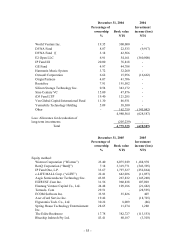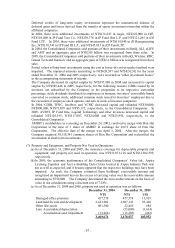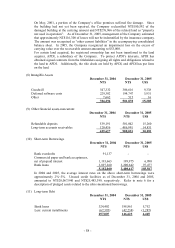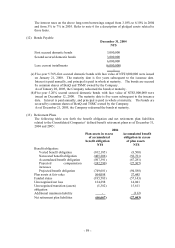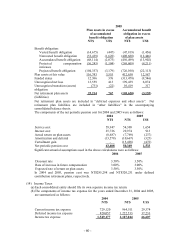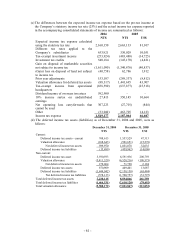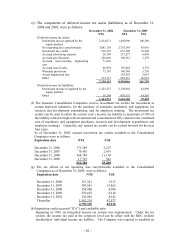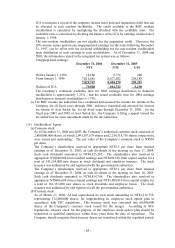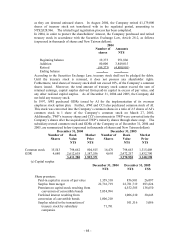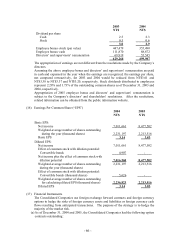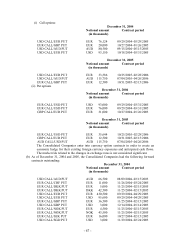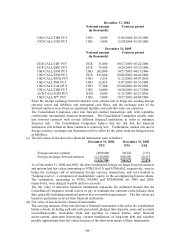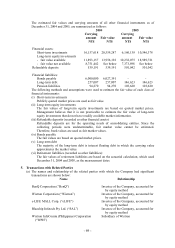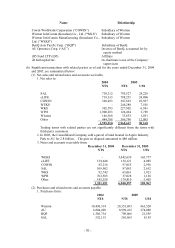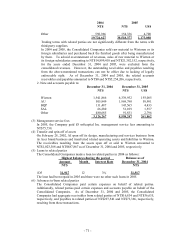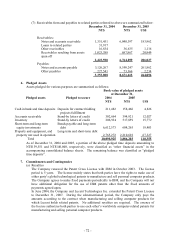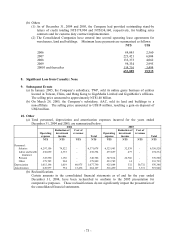Acer 2005 Annual Report Download - page 70
Download and view the complete annual report
Please find page 70 of the 2005 Acer annual report below. You can navigate through the pages in the report by either clicking on the pages listed below, or by using the keyword search tool below to find specific information within the annual report.
- 65 -
December 31, 2004 December 31, 2005
NT$ NT$ US$
Other:
Surplus from long-term equity
investments accounted for by the
equity method
267,954
1,253,402 38,173
30,541,968 30,552,133 930,475
According to the ROC Company Law, with the exception of capital surplus originating from
long-term equity investments accounted for by the equity method, any realized capital
surplus could be transferred to common stock as stock dividends after deducting
accumulated deficit, if any. Realized capital surplus includes share premium and
donations from shareholders. Distribution of stock dividends from realized capital surplus
is subject to certain restrictions imposed by the SFB.
(d) Legal reserve, unappropriated earnings, and dividend policy
The Company’ s articles of incorporation stipulate that at least 10% annual net income after
deducting accumulated deficit, if any, must be retained as legal reserve until such retention
equals the amount of authorized common stock. In addition, a special reserve should be
set up in accordance with SFB regulations. The remaining balance of annual net income,
if any, can be distributed as follows:
y 5% to 10% as employee bonuses; employees may include subsidiaries’ employees that
meet certain criteria set by the board of directors;
y 1% as remuneration for directors and supervisors; and
y the remainder, after retaining a certain portion for business considerations, as dividends
and bonuses for stockholders.
Since the Company operates in an industry experiencing rapid change and development,
distribution of earnings shall be made in view of the year’ s earnings, the overall economic
environment, the related laws and decrees, and the Company’ s long-term development and
steady financial position. The Company has adopted a steady dividend policy, in which a
cash dividend comprises at least 10% of the total dividend distributed.
According to the ROC Company Law, the legal reserve can be used to offset an
accumulated deficit and may be distributed in the following manner: (i) when it reaches an
amount equal to one-half of the paid-in capital, it can be transferred to common stock at the
amount of one-half of legal reserve; and (ii) when it reaches an amount exceeding one-half
of the authorized common stock, dividends and bonuses can be distributed from the excess
portion of the legal reserve.
Beginning in 2000, pursuant to SFB regulations, an amount equal to the total amount of any
deduction items of shareholders’ equity shall be provided from the net income of the current
year as a special reserve that cannot be distributed as dividend or bonus. Accordingly,
such special reserve shall be adjusted to reflect the changes in the deduction items. Any
reversal of the special reserve can be added back to unappropriated earnings for distribution
of dividends or bonus. As of December 31, 2004 and 2005, the Company retained a
special reserve of NT$1,261,851 and NT$2,017,819, respectively, to cover the deficiency of
treasury stock cost below market value and other deduction items of stockholder equity.
The appropriation of 2003 and 2004 earnings was approved at the shareholders’ meetings
on June 17, 2004, and June 14, 2005, as follows:


